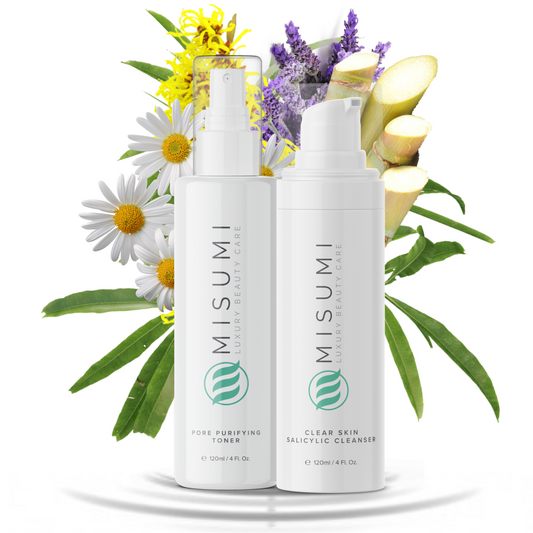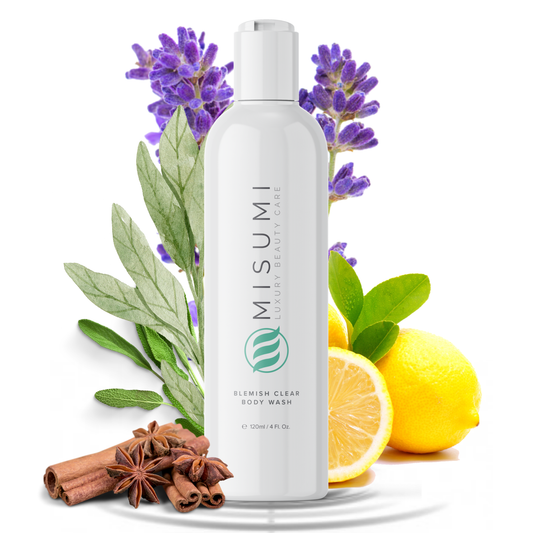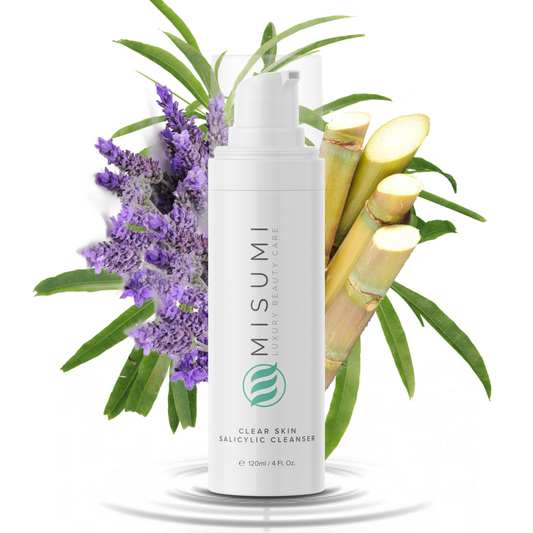Nothing feels quite as good as cleaning your face after a long day. It's like taking off a mask and feeling the kind of freedom that lets you breathe through every pore of your face.

Cleansing is the most basic step in your skincare routine and that's why it comes first after preparing your face - yet it's a crucial and fundamental step for healthy skin. We'll discuss the reasons in detail and explain the type of cleansers you can use to get that clean, exposed feeling on your face, no matter your skin type. Take Misumi's AHA 10% Skin Perfecting Cleanser, for example!
Let's start by explaining what cleansing is. We'll run you through all the different types of cleansers out there, and how to choose the right cleanser for your skin type.
Cleansing the Skin: What Does it Mean?

Cleansing is the process of removing dirt, debris, old skin cells, and makeup residue from your face. We completely understand if you're going, "so, why don't we just use the typical everyday words, like cleaning or washing the face?"
We get it. The jargon in the beauty industry can be a little confusing at times, but in this case, there's a good reason for it.
Cleansing is different from simply washing your face. This is because you're using a cleanser (a product with active cleansing ingredients) that produces a chemical reaction to stimulate the removal of pollutants and dead skin cells on the surface of the face. Think of it as a more advanced and efficient way of thoroughly cleaning the face.

Don't fear the word "chemical reaction." Even natural ingredients like lemon juice or apple cider vinegar produce strong chemical reactions if applied on the face - even diluted. Like with natural remedies, if you use the wrong ingredients, you will worsen your condition. However, if you learn to use the right ingredients for your skin type, you will improve your complexion and notice results.
That's why the beauty industry has given us a variety of different products specifically formulated to care for different skin types.
There are a lot of different types of cleansers - foam, gel, cream, and clay. Here's what you need to know about them.
Type of Cleansers
There are many types of facial cleansers out there, from cleansing balms to clay masks, so how do you decide?
But it doesn't have to be confusing at all. Let's clear the air.
Foam Cleansers

Foam cleansers are just that - facial cleansers that are foamy and lightweight. They might start off as a cream or gel but once applied on the face, they form a rich, bubbly lather meant to deep clean the skin and rid it of any impurities that may be on the skin's surface. They're very efficient in getting rid of excess oil and excess sebum, which is good news for all of you who suffer from frequent acne breakouts.
On the downside, foam cleansers usually contain sodium lauryl sulfate in their formulation, which makes them too harsh for sensitive skin. If you have a foaming cleanser and you find your skin feeling dry or irritated after cleansing, check the ingredients for this little chemical.
If this is the case, you should swap your foam cleanser for another type of facial cleanser with a gentler formula.
Gel Cleansers

The name kinda gives it away. A gel cleanser will look and feel like a typical gel. The consistency is completely different from foam cleansers, yet they're both designed for deep cleansing, clearing out clogged pores, removing excess oil, and providing your skin with antiseptic and exfoliating properties.
Gel cleansers are considered milder than foam cleansers, making them better for people with sensitive skin, especially if you're also suffering from the occasional zit. Nevertheless, they're still not the best option for sensitive skin and can cause irritation in extreme cases.
Word on the street is that most gel cleansers work well with all skin types, making them a safe option to start with.
Cream Cleansers

Creamy cleansers won't declare war on pores, but this doesn't make them ineffective. They move quite gently, cleaning pores and providing hydration as well.
Cream cleansers are generally thicker in consistency and have moisturizing ingredients that lock in the skin's natural oils.
Creamy cleansers can still give you that clear and fresh look you're after - given that you're using them on the right skin type. For example, oily skin might not benefit from them so much, but people with a dry skin type will love them.
Oil Cleansers

Now that oil cleansing is a thing, we're here to debunk the myth that if there's oil, there's a breakout.
Oil-based cleansers are a wonderful alternative for removing makeup, debris, and dead skin cells from the face, especially for people whose skin gets dry after using more traditional types of cleansers.
Water-soluble cleansers with foamy, gel or creamy textures primarily use surfactants as their main active ingredient. This process means you can rinse the skin's impurities with water. Oil cleansers, on the other hand, work by dissolving the similar substances they're attracted to - sebum.
Depending on the formulation of the product, we can argue that some oil cleansers won't make blemished skin worse, but rather help soothe irritation. However, the rule of thumb is that most oil cleansers work best for people with dry and sensitive skin.
With so many other options, cleansing oils sit at the bottom of the list for oily skin and acne-prone skin.
Clay Cleansers
Clay cleansers use the powerful absorbing properties of clay to remove impurities. Why clay, you ask? Well, they're potent detoxers. Experts agree that clay has strong pulling action and works like a magnet, bonding with the debris, old skin cells, makeup residue, and other impurities stuck in our pores.
Clay cleansers purify skin and provide a deep clean. They're also great for soothing redness and irritated pimples. So if you have oily skin, combination skin, or suffer from breakouts, consider a clay cleanser.
Micellar Cleansers

A micellar cleanser or micellar water is somewhere between a foam and a cream cleanser, providing a powerful combination of properties. This purified water is mixed with hydrating ingredients, as well as low concentrations of mild surfactants.
The goal of this facial cleanser is to use surfactants as a magnet for superficial debris, dirt, and oil, without drying off or irritating the skin. It's also great for removing makeup.
Because micellar cleansers are so mild and have hydrating properties, there's no need to rinse them off the face after applying. This makes them really practical - use them anytime and anywhere!
They're great for people with dry or sensitive skin, as well as acne-prone skin. Arguably the biggest benefit of micellar cleansers is that you can take them on the go. For example, rinse your face with lukewarm water and apply micellar water after a workout.
Powder Cleansers

Powder cleansers are a good way to gently exfoliate the skin with natural ingredients. Common ingredients found in powder cleansers are baking soda, rice bran, oats, and seeds. They provide gentle exfoliation without gritting the skin harshly.
Powder cleansers are enriched with enzymes and powerful antioxidants, offering a deep cleanse. However, they're considered harsher than liquid cleansers, and most dermatologists advise you to use them at night for seeping into the skin barrier, removing makeup, and deeply cleansing the face. Avoid using a powder cleanser if you have a sensitive skin type or if you're prone to atopic dermatitis.
Bar Cleansers

Bar cleansers are probably the most familiar and overly used type of cleanser in this group. If you have ever used a soap, then you've used a bar cleanser to clean your skin.
There are two basic types of cleansing bars – soap bars and synthetic detergent (syndet) bars.
Soap bars come with amazingly diverse formulations, forms, and scents. Although some are mild, most act abrasively on the skin and leave it dry. They might be a good choice for super oily skin, but still - syndet bars are probably the smarter option.
Syndet bars use blends of synthetic surfactants derived from oils, fats, or petroleum products. They work by surrounding debris with small particles that are later removed with water. Syndets are recommended for cleansing more sensitive skin as they are far more "skin-friendly" than traditional soaps, which have a high pH value.
It's worth noting that although they're far better than soap bars, syndets can still cause irritation on a sensitive skin type.
Cleansing Cloths, Mitts, and Sponges

Technically cloths, mitts, and sponges are considered cleansing agents because they do the actual work of removing dirt, dead skin cells, and other impurities from the skin's surface.
On the other hand, we can't really put them in the same basket as the above cleansers because these tools are the only ones that provide mechanical exfoliation of the skin's surface. The most efficient way to use them is in combination with some cleanser rather than just water.
When used in combination with a cleanser, they have the advantage of better product absorption, deeper cleansing, and improved circulation.
The disadvantage of an exfoliating cleanser tool is that rubbing the skin can really be harsh and cause redness and irritation.
You can also try cleansing wipes to keep your skin feeling moist and soft on the go. Like with other face cleansers, make sure you review the ingredients in the cleansing wipes you're planning to use.
How to Choose the Right Cleanser for Your Skin Type

Choosing the right cleanser will involve some trial-and-error for sure. It's all about figuring out what works for your skin. Every type of skin is different. Even if two people both have dry skin, it doesn't necessarily mean the same type of cleanser would work.
However, if a product works well for dry skin, and you have dry skin, start there and keep your options open for other alternatives.
Dry Skin
Cleansing can be a challenge for all skin types, but when you have a dry skin type, this process can be even more off-putting. Nevertheless, you should never skip it. Remember that cleansing is not the problem; the problem is the type of cleanser you're using.
Even though the options for dry skin are limiting, there are some good products out there.
You should start with an oil-based or cream cleanser. Micellar water will probably work for you too, but you can also use a gel cleanser.
Never leave your skin exposed after cleansing. Finish your skincare routine by applying a powerful moisturizer that will lock in water and keep your skin hydrated and soft. This is good advice for all skin types but imperative for people with dry skin or mature skin.

Sensitive Skin
A sensitive skin type can be even trickier to handle than dry skin, but let's not make it a competition.
Micellar water works well for people with sensitive skin types, so start there. You can also consider cream or other types of powder cleansers.
Although the type of cleanser is important, focus on the formulation of the product itself. Even micellar cleansers differ from one brand to another.
Those with sensitive skin types should choose a mild product with really low concentrations of active ingredients. Check for added fragrances or other irritants in the formulation.
Sometimes it's not the cleansing ingredients that are causing the problem.

Normal Skin
If you think you have normal skin (that is - it doesn't feel oily or dry, and it isn't acne-prone), then consider yourself lucky. You have a variety of products to choose from, and you can experiment with almost all types of cleansers without an adverse reaction.
Those with normal skin should try out different products to see what works best and gets their skin glowing.
Oily and Acne-Prone Skin
Using cleansing products that overdry the skin can send the sebaceous glands into overdrive and lead to more breakouts. On the other hand, using cleansing products that are creamy and have oils in their formulation can highlight that unwanted shine. So, what's left?
The expert's advice is to use foam, bar, or a clay cleanser if you have oily and acne-prone skin. Other facial cleansers that will probably work well on your skin type are gel and powder. They should get rid of excess oil and remove acne-causing bacteria without drying out your skin. Feel free to use cleansing cloths, mitts, and sponges for deep facial cleansing, but be really gentle. You don't want to burst inflamed pimples and cause an infection.
Misumi has two different cleansers for oily skin - the AHA 10% Skin Perfecting Cleanser and the Clear Skin Salicylic Cleanser.
Combination Skin

Combination skin is a mix of any of the other skin types - oily and normal, or oily and dry. In this case, cleansers that work well for all skin types are the way to go. Why not consider a gel cleanser? Micellar water is good too, although it's milder, so you might not see extreme changes.
If you have a combination skin type, use the cleansers that work well for oily skin types, such as bar, clay, and foaming cleansers. You'll want to remove excess oil. Always use a hydrating moisturizer to soothe the dry areas on your face and help maintain water and moisture.
Oil cleanser formulations with surfactants might work well on oily and combination skin.
How to Cleanse Your Skin

Step 1: Prepare The Face
If you are cleansing the skin in the morning, simply splash lukewarm water on your face to wake up every pore and remove makeup residue or the buildup of dead skin cells.
If you're cleansing in the evening, remove any makeup you have applied before starting to cleanse the skin.
This is really important because it will clear the skin and expose the pores for more efficient cleaning. No product can work if it can't reach the skin, right?
Makeup works as a wonderful barrier between the product and your actual skin tissue. If you don't remove makeup, instead of unclogging the pores and clearing the skin, cleansing would simply be a makeup-removal procedure.
Step 2: Apply Cleanser
After you have prepared your face, the next step is to apply the cleanser.

Wash your face with lukewarm water, apply a small amount of the product to your hand (you can also use cotton pads), and gently apply it on the face, massaging it for a minute in a circular motion.
Make sure you cover your whole face, from chin to forehead, avoiding sensitive areas around the mouth, nose, and eyes.
Step 3: Rinse and Pat Dry
Once you've finished massaging your face with your cleanser, rinse with lukewarm water to remove any residue from the product. Don't leave the cleanser on your face. Wash it well, and then pat it dry.
Conclusion

The fundamentals of almost every skincare routine are based on good and efficient cleansing. Aside from making you feel amazing, cleansing will keep your pores clear, prevent a buildup of dirt and pollutants, remove irritants, and stimulate circulation.
So don't you dare skip this step! Instead, learn how to do it right.
To advance your cleansing skills, consider the concentration of the active ingredient in the product's formulation, and be careful in your application. You need to prepare the skin before applying a cleanser, and you always need to moisturize afterward.









